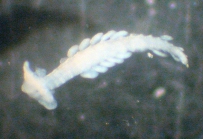RAS taxon details
Typhloscolex Busch, 1851
129722 (urn:lsid:marinespecies.org:taxname:129722)
accepted
Genus
Typhloscolex muelleri Busch, 1851 (type by monotypy)
marine, brackish, fresh, terrestrial
recent only
masculine
Busch, W. (1851). Beobachtungen über Anatomie und Entwicklung einiger wirbellosen Seethiere. August Hirschwald, Berlin, pp. 143, pls 1-17., available online at https://www.biodiversitylibrary.org/page/9996133 [details] 
Read, G.; Fauchald, K. (Ed.) (2025). World Polychaeta Database. Typhloscolex Busch, 1851. Accessed through: RAS (Eds.) (2025) Register of Antarctic Species at: https://ras.biodiversity.aq/aphia.php/aphia.php?p=taxdetails&id=129722 on 2025-09-12
RAS (Eds.) (2025). Register of Antarctic Species. Typhloscolex Busch, 1851. Accessed at: https://ras.biodiversity.aq/aphia.php?p=taxdetails&id=129722 on 2025-09-12
Date
action
by
2006-09-28 06:51:36Z
changed
Martinez, Olga
original description
Busch, W. (1851). Beobachtungen über Anatomie und Entwicklung einiger wirbellosen Seethiere. August Hirschwald, Berlin, pp. 143, pls 1-17., available online at https://www.biodiversitylibrary.org/page/9996133 [details] 
additional source Bellan, G. (2001). Polychaeta, <i>in</i>: Costello, M.J. <i>et al.</i> (Ed.) (2001). European register of marine species: a check-list of the marine species in Europe and a bibliography of guides to their identification. <em>Collection Patrimoines Naturels.</em> 50: 214-231. (look up in IMIS) [details]
additional source Neave, Sheffield Airey. (1939-1996). Nomenclator Zoologicus vol. 1-10 Online. <em>[Online Nomenclator Zoologicus at Checklistbank. Ubio link has gone].</em> , available online at https://www.checklistbank.org/dataset/126539/about [details]
additional source Day, J. H. (1967). [Errantia] A monograph on the Polychaeta of Southern Africa. Part 1. Errantia. British Museum (Natural History), London. pp. vi, 1–458, xxix., available online at http://www.biodiversitylibrary.org/bibliography/8596 [details]
additional source Bellan, G. (2001). Polychaeta, <i>in</i>: Costello, M.J. <i>et al.</i> (Ed.) (2001). European register of marine species: a check-list of the marine species in Europe and a bibliography of guides to their identification. <em>Collection Patrimoines Naturels.</em> 50: 214-231. (look up in IMIS) [details]
additional source Neave, Sheffield Airey. (1939-1996). Nomenclator Zoologicus vol. 1-10 Online. <em>[Online Nomenclator Zoologicus at Checklistbank. Ubio link has gone].</em> , available online at https://www.checklistbank.org/dataset/126539/about [details]
additional source Day, J. H. (1967). [Errantia] A monograph on the Polychaeta of Southern Africa. Part 1. Errantia. British Museum (Natural History), London. pp. vi, 1–458, xxix., available online at http://www.biodiversitylibrary.org/bibliography/8596 [details]
 Present
Present  Inaccurate
Inaccurate  Introduced: alien
Introduced: alien  Containing type locality
Containing type locality
